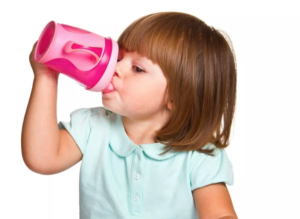Sippy Cups: 3 Reasons to Skip Them

3 Reasons to Skip Them and What to Offer Instead
In the article Step Away from the Sippy Cup, I discussed how the sippy cup was invented for parents, not for kids. An engineer got fed up with his toddler spilling juice on the carpet and the rest is history. Today, sippy cups are marketed to parents as a vital piece of feeding equipment, causing parents to consider sippy cups an essential part of a baby’s development. As a speech-language pathologist and feeding specialist, I beg to differ on this point. Here’s why:
- As a baby matures, so does their swallow pattern, and over-use of hard sippy spouts may get in the way of development. During the first year of life, a baby primarily uses an anterior-posterior tongue movement to propel soft solids and liquids to the back of the mouth for swallowing. This is referred to as the infant suckle-swallow pattern. At around a year old, babies should develop a mature swallow pattern, where the tongue tip rises to the alveolar ridge (the bumpy gum-line ridges where we produce the /d/ sound) to start a wave-like motion in the tongue for swallowing more advanced textures. Drinking exclusively from a bottle or hard-spouted sippy cup might delay this feeding development. A bottle nipple or hard spout rests over the front third of the tongue, preventing that essential elevation so necessary for being an effective and efficient eater. When toddlers continue to use the infant swallow pattern, chewing and swallowing new foods can be challenging or messy at best.
- When a tongue can’t elevate, it tends to rest forward in the mouth, which can impede speech and language development. Often referred to as “paci-mouth,” the forward resting posture is seen in children who continue to use a pacifier for a prolonged period. The occasional use of a sippy cup may not interfere with age-appropriate mouth development. In today’s society, however, kids seem to have sippy cups with them most of the day. Strollers, car seats, and backpacks usually contain special holders for a beverage container and parents often choose spill-proof, hard-spout sippy cups. When a child uses a “suckle-swallow” pattern past the developmental timeframe of 6 to 12 months, his speech-language skills can’t migrate to more advanced skills until a more appropriate swallowing pattern is established.
- When a tongue rests forward, the mouth tends to stay open, which can alter appropriate facial development. Kristie Gatto certified SLP and orofacial myologist states that the overuse of the suckle-swallow uses genioglossus muscle movement and promotes a tongue that rests low and forward in the oral cavity. This posturing exacerbates the lowering of the jaw musculature and typically leads to mouth breathing. Current research helps facilitate a better understanding of the detriments associated with mouth breathing and a lack of appropriate facial development.
Terrific alternatives can still protect from spills:
- Pop-up straw cups, like the Playtex Sipster, are guaranteed by Playtex to be leak-free. Once the child masters straw drinking, suggest to parents cutting down the straw so the tip of the straw just reaches the tip of the tongue when the mouth is closed around the straw. This ensures the tongue can still elevate.
- Fun valved toppers, like the Good2Grow Spill-Proof Bottle Toppers. These character bottle toppers also help motivate kids to drink more water.
- Aluminum options with built-in straws, like the Kid Basix Safe Sippy Cup (actually a straw cup) with a straw specifically designed to be short and angled for little mouths.
- Some children with special medical needs may require a valved sippy cup to maintain a safe swallow. For your clients in speech, language, or feeding treatment, you can determine the best cup for their needs. Ideally, children learn to drink from a straw cup by 9 months of age and an open cup, held by a parent, in the first year of life. Independent open-cup drinking, albeit somewhat messy at times, should be learned by 18 months of age.
Melanie Potock, MA, CCC-SLP, treats children from birth to teens who experience difficulty eating. She wrote the upcoming book, “Adventures in Veggieland: Help Your Kids Learn to Love Vegetables with 101 Easy Activities and Recipes.” Potock also co-authored “Raising a Healthy Happy Eater: A Stage-by-Stage Guide to Setting Your Child on the Path to Adventurous Eating” (2015), “Baby Self-Feeding: Solid Food Solutions to Create Lifelong Healthy Eating Habits” and “Happy Mealtimes with Happy Kids,” and produced the kids’ CD “Dancing in the Kitchen: Songs that Celebrate the Joy of Food!” Potock’s two-day course on pediatric feeding is offered for ASHA CEUs. She is an affiliate of ASHA Special Interest Group 13, Swallowing and Swallowing Disorders (Dysphagia). mymunchbug.com/contact-us/
